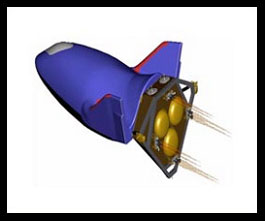|

X38
vehicle

X38
De-orbit
Propulsion Stage

Thruster
Fault Detection for the X38
|
OBJECTIVES:
Increase the safety, accuracy
and efficiency of navigation control for the X38/CRV :
The
Smart Systems Research Lab at NASA Ames Research Center is developing
advanced fault detection technologies for the X38/CRV, in collaboration
with NASA Johnson Space Center (Code EG - Aeroscience and Flight
Mechanics Division). This effort focuses on identifying in near
real-time single/multiple hard thruster failure, thruster leaks,
and vehicle mass property. This work also includes adaptive reconfiguration
control based on the identified thrusters and mass property for
a class of future spacecrafts.
For
the X38 vehicle, thruster failures are difficult to detect because
of the limited sensor capabilities. For the CRV, mass property is
difficult to determine accurately as the number of crew members
can vary, and the payload brought onboard varies as well. The approach
being applied is to use advanced identification technologies and
adaptive neural control to provide optimal control of the spacecraft.
This approach does not require a mathematical model of the spacecraft
a priori but instead it effectively learns an accurate model of
the spacecraft from its behavior. The controller uses gathered data
from a set of navigational sensors to quasi-statically learn an
accurate model of the spacecraft performance. In this manner, the
controller can control the spacecraft under a variety of changing
conditions such as varying mass, changing center-of-mass location,
thruster degradations, failures, and leaks. Optimization methodologies
are then used to achieve optimal performance.
|